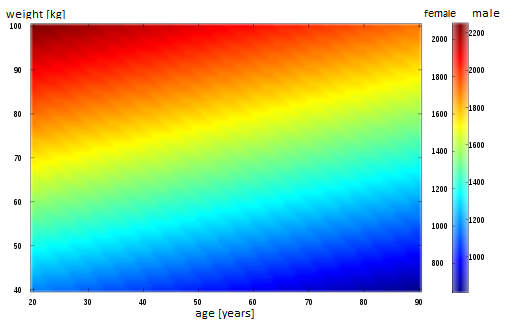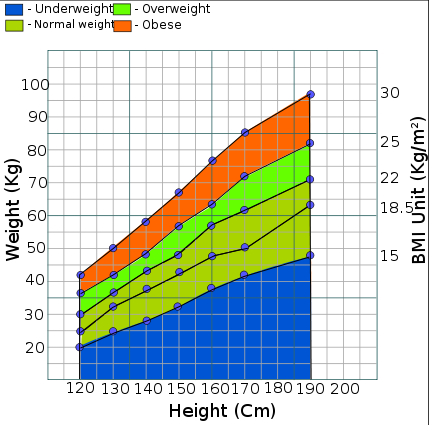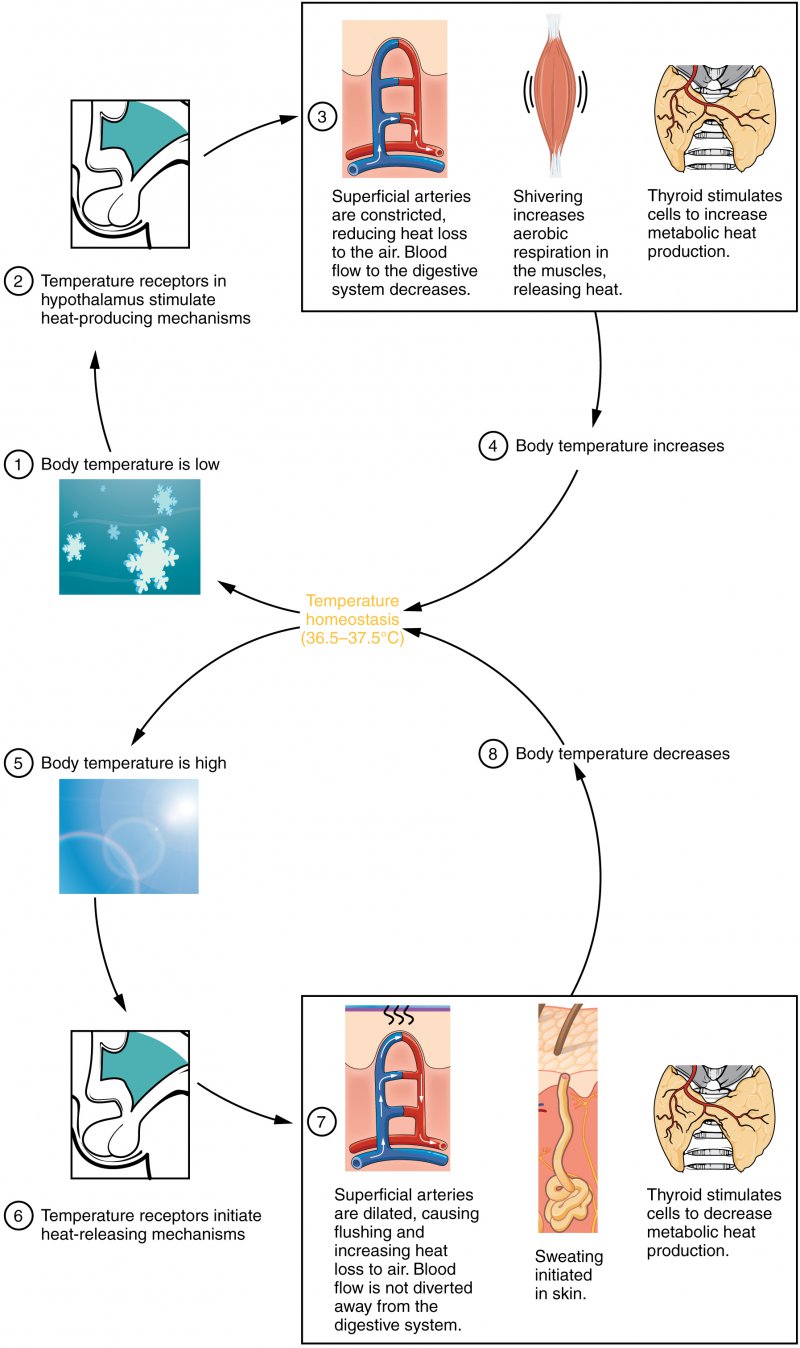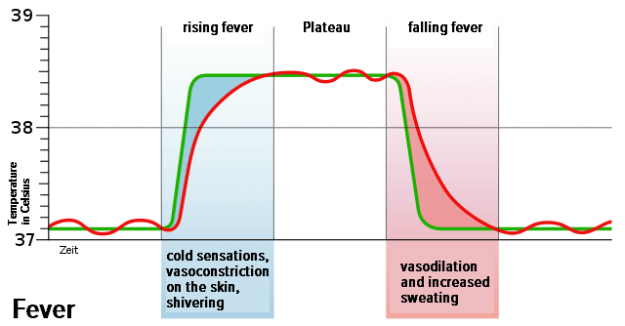Energy Balance and Thermoregulation of Humans
In Lecturio :) The stability of energy balance and thermoregulation is essential for humans’ survival. Energy that is needed to fuel the body’s functions can be obtained from different energy sources. In this process, heat is generated and, in order to maintain the body temperature constant despite a strongly altering ambient temperature, a flexible regulatory system is required. In this context, the following definitions and formulas will be very useful for medical students.
Table of Contents
Image: “Photo of sweating at Wilson Trail Stage 1” by Minghing. License: CC BY-SA 3.0
Energy Balance in Humans
Energy and Power
From a physical point of view, energy is the storage form of work. Energy is expressed in the unit of joules [J] (1 joule = N*m). It can exist in many different forms, including kinetic, thermal, and electrical forms. The unit of calorie [cal] is used to describe heat (thermal energy) and the energy value of food. The following applies: 1 cal equals 4,187 joule.
In physics, the human energy metabolism is seen as power (energy/time) and is measured in watt [W] (1 watt = 1 joule/s). Mostly, however, the whole day is taken into consideration, and value is given by joule/day.
Energy Metabolism
Different processes responsible for the basic vital functions of the human body are constantly running without interruption. They require a basal amount of energy which is called basal metabolic rate (BMR). The basal metabolic rate is defined at 4 standard conditions:
- Complete physical and mental rest
- Sober stomach
- Indifference temperature
- Early-morning hours

Image: “Base metabolism rate of men and women” by Shaddim. License: CC BY-SA 3.0
The measuring has to be carried out in the early morning because of the circadian rhythm of body temperature which, concomitant to the energy metabolism drops to a minimum during these hours.
In order to estimate an approximate basal metabolic rate of a healthy individual, the following formula is used: The basal metabolic rate is approx. 100 kJ per mass in kg per day, or 1 watt/kg. Thus, the basal metabolic rate of an individual with the body mass of 70 kg is about 7000 kJ/d.
The basal metabolic rate increases with fever, cold adaptation, and is also influenced by cortisol (stress) and thyroid hormones (hyperthyroidism). Naturally, women have lower basal metabolic rate than men.
When energy metabolism is increased by mental or light physical activity, it is called exercise metabolism. Its rate is about 30% higher than the basal metabolic rate. When the metabolism rate significantly increases due to physical activity, it is referred to as work metabolism.
Energy Sources and their Calorific Value
To satisfy a human’s energy demand, and to maintain a constant energy balance, high-energy nutrients have to be utilised (or ‘burnt’). The energy is supplied by three essential food substrates – carbohydrates, fats and proteins.
A distinction is made between the physical and physiological calorific value. The physical calorific value of nutrients refers to the absolute energy content, while the physiological calorific value is the portion of the energy that is used by the human body.
In food utilisation, it affects only proteins, since people cannot use their entire energy (23 kJ/g) and excrete it in the form of unusable but energy-rich urea. Thus, the physiological calorific value is lower than the physical.
Calorimetry and Caloric Equivalent
The act of measuring energy metabolism is called calorimetry. Direct calorimetry, through measuring the heat generated by a combustion reaction, is no longer used. In turn, indirect calorimetry is still widely used in sports medicine and occupational medicine. In this case, the consumed energy is calculated from the consumption of oxygen.
In order to estimate the amount of energy from the consumption of oxygen, the caloric equivalent (CE) is needed. It refers to the energy released, per litre of oxygen consumed, during the combustion of a particular substrate. The caloric equivalent of the diet of an average Central European is 20 kJ per litre of consumed oxygen. The caloric equivalents of different nutrients are organised in the following table. In order to estimate one’s consumption of oxygen, spirometry is typically used.
Respiration Quotient
The caloric equivalent of 20 kJ per litre of consumed oxygen applies to the Central European mixed diet, and can vary depending on diet composition. Since the caloric equivalents for carbohydrates, fats and proteins lie between 19 kJ and 21 kJ per litre of O2, the possible error is minimal.
However, in order to achieve a higher accuracy, one should identify the primary energy substrate on the basis of respiration quotients (RQ). This refers to the ratio of emitted CO2 to consumed O2 and lies between 0.7 and 1.0 (depending on the diet). The following table provides the respiration quotients for exclusive combustion of each substrate. The emission of CO2 is also estimated using the open circuit spirometry.
Body Mass Index (BMI)
The imbalanced energy balance can increase or decrease the body weight and thus the body mass index (BMI). The elevation of the BMI can be a result of the increase in fat tissue during a long period of a positive energy balance, but can also reflect the increase in muscle mass of an athlete. If the BMI is greater than 30, there is a higher risk of cardiovascular diseases and diabetes mellitus, and therefore, a dramatically increased mortality rate.
Image: “Simplified graph of body mass index” by Amog. License: CC BY-SA 3.0
Optimal Diet Composition
The proportion of various nutritional elements in a balanced diet should be based on the following: the recommended daily consumption of protein is 1 g per kg of body weight. This is called protein optimum, and it ensures the daily conversion of structural proteins.
The energy required by the human body should be provided to 50% of carbohydrates, 30% of fats and 10% of proteins. Alcohol often provides 5% of the daily energy requirement, but it should not, under any circumstances, cover a bigger percentage.
Thermoregulation in Humans
The reliable functioning of the human body depends on a constant body temperature. There are different regulatory mechanisms in order to ensure and secure it, despite strongly altering external conditions.
The heat produced by combustion must be used, on the one hand, to stabilise a body’s temperature and, on the other hand, can be emitted to the environment if there is surplus energy. A normal body temperature is approx. 37 °C, but varies depending on the circadian rhythm by about 1 °C.
Regulation of the Body Temperature
The ability to maintain a constant body temperature of about 37 °C is called thermoregulation, and the centre of temperature regulation and metabolic regulation is in the hypothalamus. Both there, and in the periphery, are the cold receptors and the heat receptors (thermoreceptors), which convey their information to the thermoregulatory centre. Here the so-called temperature setpoint is set, i.e. the temperature that the body is trying to maintain.
Two temperature conditions are distinguished: the core temperature (the temperature of the vital organs) and periphery (the temperature of extremities). The thermal exchange takes place via the bloodstream. The first priority of the body is to maintain the core temperature. When the ambient temperature drops, the bloodstream in the periphery is reduced so that the decrease in temperature only affects the extremities, but not the body core.
This reaction to mild hypothermia is called centralisation; it prevents too much heat to be lost through the larger surfaces of the extremities. Therefore, in cold conditions, the temperature of the body periphery can differ from the core temperature by up to 9 °C. From the outside, pale skin and bluish lips can be observed. In warm conditions, the vessels of the skin are dilated and perfusion of the periphery is increased. In this case, the temperature of the core, and of the periphery, converges to a large degree.
Indifference Temperature
The range of temperature which is comfortable for humans, and which requires little effort from the thermoregulatory system and can be maintained by normal blood circulation, is called indifference temperature. For an unclothed, resting person at a relative air humidity, it lies around 28-30 °C; for a clothed person, around 22 °C. Outside this zone, various mechanisms have to be used in order to ensure the constant body temperature of 37 °C.
Heat Generation
As a result of chemical reactions, especially combustion reactions, the human body produces heat. The heat generation of individual organs at rest, and under stress, and their respective share of the total generated heat, differ strongly. In particular, muscle activity can significantly increase heat generation and provide a 90% share of heat.
In addition to the increasing urge to move one’s body in cold weather in the form of arbitrary muscle activity, heat can be also produced by shivering. This involuntary reaction reflectively activates antagonists, which results in no actual movement.
The well-perfused and energy-rich brown adipose tissue provides a form of heat generation that is of utmost importance for an infant. It is called non-shivering thermogenesis. The membrane protein thermogenic, or UCP-1 (= uncoupling protein 1), uncouples the respiratory chain. Thus, the breakdown of fatty acids is “short-circuited” so that no ATP is formed and all the energy in the form of heat will be emitted. Thus, stimulated by the beta-adrenergic receptors, the heat can be supplied very quickly.
Heat Emission
During heavy physical labour, the human body produces thermal energy (mostly through muscular activity). In order to emit this surplus heat, the human body uses four different mechanisms.
Thermal conduction implies the emission of heat through the skin, while directly contacting with another material. As a result of this contact, a person loses heat, and the extent of this heat exchange largely depends on the material’s thermal conductivity. This is why highly conductive metal seems much colder to us than, let’s say, wood, and more heat is lost through conduction.
Convection, on the other hand, is the transfer of heat to a medium in motion– mostly air that surrounds us. The body surface warms the still layer of air, which then rises and is replaced by colder air. If the medium is in motion, the exchange accelerates, and thus the heat transfer increases, and this is why a perceived temperature is colder in windy weather. The loss of heat in a medium with a higher conductivity (like water, for instance) is also greater. Under standardised conditions, about 15% of heat is emitted through convection.
In contrast to conduction and convection, no direct contact is involved in thermal radiation (infrared radiation). Everybody continually emits energy to the objects in the environment. The extent of this emission depends on the temperature differential. On average, about 60% of the heat of the human body is emitted through thermal radiation.
Evaporation is an effective mechanism of the human body which is also needed for emitting surplus heat, especially at ambient temperatures above 36 °C, as it is the only one available. Sweating (perspiratio sensibilis) is a body regulated process that is influenced by cholinergic fibers of the sympathetic nervous system. Perspiratory glands exclusively contain cholinergic receptors. Their neurotransmitter is acetylcholine.
The evaporation heat of water is 2400 kJ/l, which allows for a high level of heat emission, which is, however, limited by a high level of air humidity. If a person loses a great amount of low-electrolyte liquid through sweating, it can lead to hypertonic dehydration. Daily, the human body involuntarily loses up to 500 ml of liquids through evaporation from the skin and mucous membranes (e.g., of the airways). This phenomenon is called perspiratio insensibilis, and despite the lack of regulatory mechanisms, it contributes not involuntarily to the heat emission.
Fever
Hyperthermia occurs when the core body temperature increases due to, for instance, intensive physical stress and the mechanisms of heat emission are insufficient. In case of fever, however, the temperature setpoint increases in the centres of the central thermoregulatory network. This can have different causes. Mostly, bacterial inflammations are responsible for it, but it can also be a result of malignant processes.
The substances responsible for increasing the temperature setpoint are known as a group of so-called pyrogens. The group of foreign, exogenous pyrogens consists of viruses and constituents of bacteria (polysaccharides), which, through the interaction with macrophages and granulocytes, lead to the release of the messenger substances of the immune system. These mediators, in turn, are known as endogenous pyrogens. The major endogenous pyrogens are interleukin 1 (IL-1), interferon, and tumor necrosis factor. At the end of the cascade are prostaglandins, which induce the increase of the temperature setpoint in the hypothalamus.
Image: “Course of fever. Green line marks the set-point, red the actual body temperature.” by DooFi. License: Public Domain
In order to assess the situation of a patient with fever, several clinical signs of rising or falling fevers can be used. Patients with a rising fever experience strong cold sensations, vasoconstriction on the skin and shivering, since the body core temperature is below the (increased) temperature setpoint. In contrast, a falling fever causes vasodilation and increased sweating. The medication that reduces fever is called antipyretics and they work, like ibuprofen, for instance, by inhibiting prostaglandin synthesis.
Review Questions
Solutions can be found below the references.
1. How much fat can provide the same amount of energy as 50 g of starch?
- About 100 g
- About 850 g
- About 39 g
- About 21 g
- About 50 g
2. How much energy does the human body require in the case of a mixed diet and an oxygen consumption of 12 l?
- 1200 kJ
- 240 kJ
- 120 kcal
- 300 J
- 120 kJ
3. Which of the following statements about thermoregulation is false?
- At rest, thermal radiation produces the most heat.
- Shivering is a body’s voluntary response to the cold.
- Thermoregulation is essentially carried out in the hypothalamus.
- Pyrogens cause the increase of the temperature setpoint of humans.
- Perspiratory glands are stimulated via cholinergic receptors for acetylcholine.




Comentários
Enviar um comentário